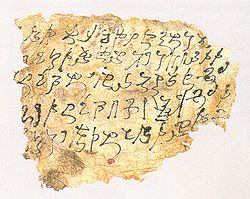
Back Kharosthi Afrikaans खरोष्ठी लिपि ANP খৰোষ্ঠী লিপি Assamese খরোষ্ঠী লিপি Bengali/Bangla Kharosthi Catalan Kharóšthí Czech Kharoshthi-Schrift German Ĥaroŝti Esperanto Karosti Spanish خروشتی Persian
| Kharosthi 𐨑𐨪𐨆𐨮𐨿𐨛𐨁𐨌 | |
|---|---|
 | |
| Script type | |
Period | 4th century BCE – 3rd century CE |
| Direction | Right-to-left script |
| Languages | |
| Related scripts | |
Parent systems | |
Sister systems | |
| ISO 15924 | |
| ISO 15924 | Khar (305), Kharoshthi |
| Unicode | |
Unicode alias | Kharoshthi |
| U+10A00–U+10A5F | |
| Part of a series on |
| Numeral systems |
|---|
| List of numeral systems |
Kharosthi script (Gāndhārī: 𐨑𐨪𐨆𐨮𐨿𐨛𐨁𐨌𐨫𐨁𐨤𐨁, romanized: kharoṣṭhī lipi), also known as the Gandhari script (𐨒𐨌𐨣𐨿𐨢𐨌𐨪𐨁𐨌𐨫𐨁𐨤𐨁, gāndhārī lipi),[1] was an ancient script originally developed in the Gandhara Region of modern-day Pakistan,[2][3] between the 5th and 3rd century BCE.[4][5][6] used primarily by the people of Gandhara alongside various parts of South Asia and Central Asia.[7] it remained in use until it died out in its homeland around the 5th century CE.[7]
It was also in use in Bactria, the Kushan Empire, Sogdia, and along the Silk Road. There is some evidence it may have survived until the 7th century in Khotan and Niya, both cities in East Turkestan.
- ^ Leitich, Keith A. (2017). "Kharoṣṭhī Script". Buddhism and Jainism. Encyclopedia of Indian Religions. Springer Netherlands. pp. 660–662. doi:10.1007/978-94-024-0852-2_238. ISBN 978-94-024-0851-5.
- ^ Violatti, Cristian. "Kharosthi Script". World History Encyclopedia. Retrieved 4 May 2025.
- ^ Salomon, Richard; Allchin, Frank Raymond; Barnard, Mark (1999). Ancient Buddhist Scrolls from Gandhāra: The British Library Kharoṣṭhī Fragments. University of Washington Press. ISBN 978-0-295-97769-0.
The earliest recognizable examples of Kharosthi have been located in the region of Gandhara (northern Pakistan), recorded in the Ashokan edicts (mid-3rd century BCE) at the towns of Mansehra and Shahbazgarhi.
- ^ "Kharoshti | Indo-Parthian, Brahmi Script, Prakrit | Britannica". www.britannica.com. Retrieved 14 February 2025.
- ^ "When these alphabets were first deciphered, scholars gave them different names such as 'Indian-Pali' for Brahmi and 'Arian-Pali' for Kharosthi, but these terms are no longer in use." in Upāsaka, Sī Esa; Mahāvihāra, Nava Nālandā (2002). History of palæography of Mauryan Brāhmī script. Nava Nālanda Mahāvihāra. p. 6. ISBN 9788188242047.
- ^ Salomon 1998, pp. 11–13.
- ^ a b R. D. Banerji (April 1920). "The Kharosthi Alphabet". The Journal of the Royal Asiatic Society of Great Britain and Ireland. 52 (2): 193–219. doi:10.1017/S0035869X0014794X. JSTOR 25209596. S2CID 162688271.
© MMXXIII Rich X Search. We shall prevail. All rights reserved. Rich X Search